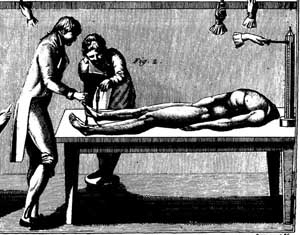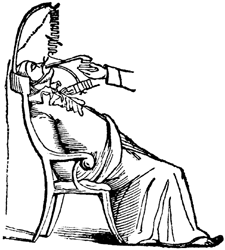
Science fiction is found in that ambiguous zone between desire and feasibility. The wings of Icarus were fantasy, drawn from desire: humans have always wanted to fly. The wings of a 747 are technology, no fantasy required. Somewhere between Icarus and the 747 are the airships of Jules Verne -- none yet made, details unclear, but definitely verging on the possible. Fiction, with an underpinning of science.
Early in the nineteenth century, young Mary Shelley set out to write a ghost story. Instead, she created one of the enduring works of science fiction: Frankenstein; or, The Modern Prometheus. The core of the novel is the creation of life from un-life, and Victor Frankenstein discovers the terrific secret by an eminently reasonable research program: study the path from life to death, then try to reverse the process.
"I paused, examining and analyzing all the minutiae of causation, as exemplified in the change from life to death, and death to life, until from the midst of this darkness a sudden light broke in upon me ..."
Such a program is not scientific per se; without background, it's mere handwaving. But in 1816, science was beginning to feel it had a handle on the secrets of life. Mary moved in intellectual circles -- Shelley, Byron, Dr. Polidori -- and they discussed the issues of the day. As she noted in the preface to the 1831 edition of Frankenstein:
"Many and long were the conversations between Lord Byron and Shelley, to
which I was a devout but nearly silent listener. During one of these, various
philosophical doctrines were discussed, and among others the nature of the
principle of life, and whether there was any probability of its ever being
discovered and communicated. They talked of the experiments of Dr. [Erasmus]
Darwin, (I speak not of what the Doctor really did, or said that he did, but, as
more to my purpose, of what was then spoken of as having been done by him) who
preserved a piece of vermicelli in a glass case, till by some extraordinary
means it began to move with voluntary motion. Not thus, after all, would life be
given. Perhaps a corpse would be re-animated; galvanism had given token of such
things: perhaps the component parts of a creature might be manufactured, brought
together, and endued with vital warmth." 
"Galvanism had given token of such things" indeed. Jean Aldini, Galvani's nephew, was famous in this sense. In the London of 1802, he experimented upon the cadavers of executed criminals. He found they retained muscular irritability for two hours, and that he could excite many of the motions of life by application of current from a Voltaic Pile. While Aldini wrote a sober and scientific book on Galvanism and its uses, he nonetheless suffered the gibes of satirists. One anonymous poem said:
For he ('tis told in public papers),
Can make dead people cut droll
capers,
And shuffling off death's iron trammels,
To kick and hop like
dancing camels.
This is an unsympathetic view of Aldini's experiments; for balance, we have
the Re-Animation Chair of Dr. De Sanctis, a vision more parallel to those of
Aldini and Frankenstein. It was a form of "Code Blue" cart: a chair whose
resuscitation equipment included a bellows with laryngeal tube to inflate the
lungs, a heated globe to create inhalant vapors -- and a Voltaic pile.
"The brain and the heart should be stimulated by passing through them the Galvanic fluid. [...] one of the wires is to be applied to the tube passed down the gullet, whilst the other is to be successively made to touch different parts of the external surface of the body, particularly about the regions of the heart, the diaphragm, and the stomach during the inflation of the lungs ..."
In short, Dr. De Sanctis recommended cardiac electrostimulation via esophageal and external electrodes, in an attempt to get a stopped heart beating again. This is little different in concept from defibrillation and external pacing, both practiced in modern medicine.
Finding evidence of scientific patterns of thought would confirm the scientific background of Frankenstein. In the novel, Frankenstein does NOT sew the Monster together from assorted corpses; he makes him from scratch.
"... I began the creation of a human being. As the minuteness of the parts formed a great hindrance to my speed, I resolved ... to make the being of a gigantic stature ..."
Make the prototype large; defer worries about getting it the proper size. We have an engineering mind at work here, as well as an artist!
Students of literature may take issue with Frankenstein as science fiction; they prefer to see it as allegory, Gothic Romance, or an updated Faustus. But it's a poor work of fiction that can be read in only one way. The juxtaposition of the fictional Frankenstein with the actual Aldini and De Sanctis ties the work firmly to the science of its time.
References:
Shelley, Mary, Frankenstein, or the Modern
Prometheus (London, 1818)
Shelley, Mary, in the introduction to
Frankenstein, or the Modern Prometheus (Third Edition, London,
1831)
Aldini, Giovanni (known as Jean Aldini in England), Essai Theorique
et Experimental sur le Galvanisme (Paris, 1804)
Reece, Richard, The
Medical Guide ... (London, 1820)
Rieger, James, Frankenstein ...
edited, with variant readings, an introduction and notes (New York, 1974)